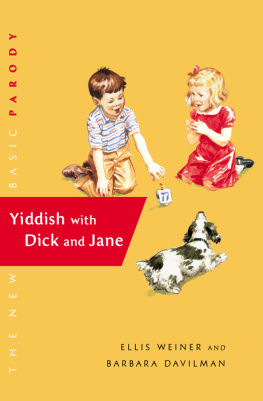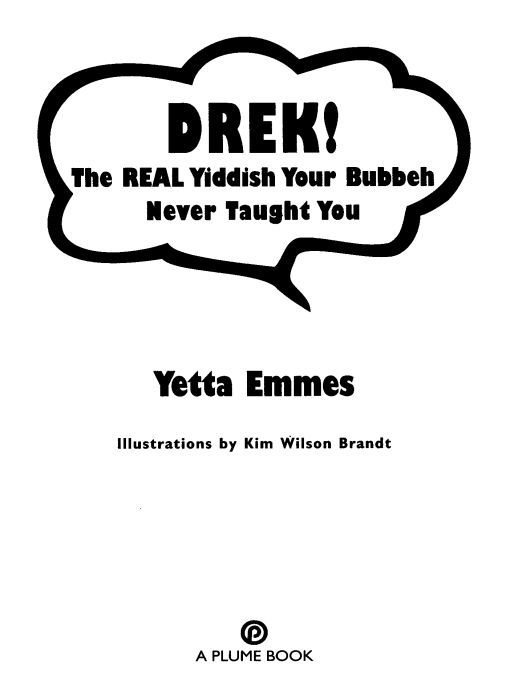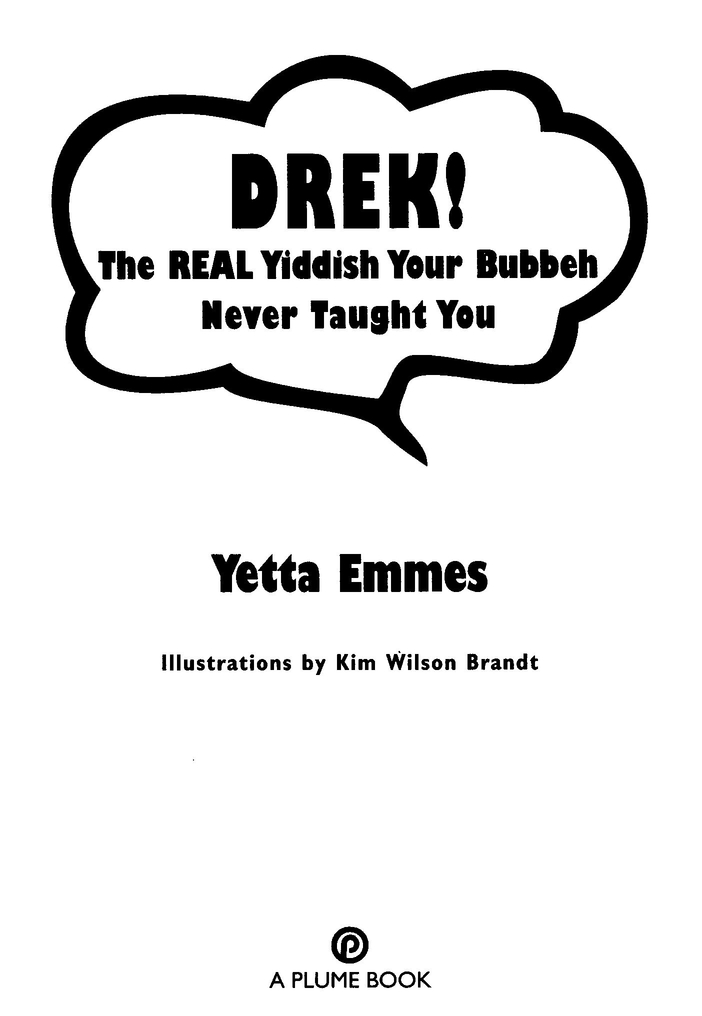Table of Contents
DREK!
The Real Yiddish You Should Be So Lucky to Learn
BULVON
A man whos built like an ox
(and acts like one, too).
GAY IN DRERD
Drop dead
(literally, go into the ground).
TUKHES LECHER
A butt kisser.
ZAFTIG
A plump, appealing woman
(literally, juicy).
PUPIK
Belly button.
FREG NIT
Dont ask.
Introduction
When Mark Twain said, Reports of my death are greatly exaggerated, he could have been speaking for Yiddish. Its been called a dying language for a hundred years and yet you wont have to look very hard to find Yiddish speakers in almost all parts of the worldmillions of them. It is truly an international language. In New York, London, Paris, Buenos Aires, Jerusalem, and countless other locales youll hear Yiddish folk chattering away in their ancient tongue, doing business, telling jokes, talking philosophy, gossiping, counseling their children and, of course, arguing.
And youll find Yiddish-language departments in universities throughout the United States, and Yiddish study classes in synagogues and community centers. And you can see Yiddish theater companies performing old and new plays for eager audiences in New York and Miami, and then, like their famous thespian forerunners (from Jacob Adler to Molly Picon), taking their troupes on international tours.
Youll also encounter countless Yiddish expressions that have crept into English and other languages. Call someone a shmuck, a nudnik, a gonif, or a kibbitzer, youre speaking Yiddish. Of course, a language with such chutzpah isnt about to fold up and die. Ah, but if you are a goy or an assimilated Jew, you may not know what chutzpah means. You may not even know what goy means. Well, heres your first Yiddish lesson. A goy is anyone who is not Jewish, be it a guy goy (a shaygetz) or a girl goy (a shikseh), and sometimes nonobservant Jews are also referred to (unflatteringly) as goys, as in Youre such a goy.
Returning to chutzpah, in todays American vernacular, it might be translated as having balls. When you compliment someone for his chutzpah, youre saying he is daring, that hell stand up to the big guy (King David had chutzpah; Barbara Walters has chutzpahnote that women can have balls too). But you can also criticize someone for his chutzpah (He has such chutzpah). Then youre saying he goes too far, he has unmitigated gall, hes in your face. Hes beyond nervy; hes got some nerve.
Whether you are goy or Jew, you probably do know a host of Yiddish words that have made their way into every arena of modern life, from show business to law. For example, a recent law journal noted that since 1980 the word chutzpah has appeared in judicial decisions 101 times (maybe judges have more chutzpah these days). And the word shmuck appeared fifty-nine times in reference to a litigant (as in, My client admits he was a shmuck for doing that, but Your Honor ...); it even appeared once in a case before the Supreme Court.
So, where did this vibrant language begin? Scholars trace its origins back a thousand years to the tenth century, when Jews were chased from northern France (so what else is new?) and settled in German cities along the Rhine. By the fifteenth century Yiddish had evolved into a distinct language, similar to German but with its own pronunciation and linguistic characteristics. Its not surprising that speakers of German and Yiddish can often understand each other to some degree.
Even though many of its words derive from Hebrew and Aramaic, and though it is written in the Hebrew alphabet, Yiddish is a European languagethe mameh loshen (or mother tongue) of the Ashkenazim, the Jews of Europe. It was never spoken by the Sephardic Jews of Spain and Portugal, nor by their descendants who migrated to Syria, Egypt, and other Middle Eastern communities after they were kicked out of Spain by Queen Isabella in 1492 (a very bad year for both Jews and Native Americans).
Like any living language, Yiddish continued to evolve over the centuries. As the Jews migrated into the various countries of Eastern Europe, Yiddish was enriched by words and phrases derived from the languages of the countries where they settled, such as Poland, Russia, Hungary, and Romania. In turn, Yiddish evolved into a number of different dialects, such as Litvak (from Lithuania) and Galiciana (from Galicia, which spanned parts of Poland and the Ukraine).
Yiddish is the language of a culture, not of a country (Hebrew is the official language of Israel, and, of course, the language of the Jewish religion). Yiddish was heard in the ghettos and shtetls, and in the many other large and small Jewish communities spread across Central and Eastern Europe. But, as we all know too well, during the past hundred years the Jews fled those communities in two massive waves. Around the turn of the century, they left Czarist Russia (think Fiddler on the Roof, only worse), and during the Nazi era, those who could fled from just about everywhere else in Europe. Jews were scattered all over the world from Shanghai and Caracas to Johannesburg and Montreal. But for the most part the European Jewish culture resettled in the United States, with New York City its unofficial capital.
Soon Yiddish became the language of Delancey Street and the Lower East Side, and Williamsburg and Ocean Parkway and the Grand Concourse and the garment center in Midtown Manhattan. In the summers you could hear it in the Catskills, and in the winters in Miami Beach. Soon you could hear it on Maxwell Street in Chicago, in the Dorchester section of Boston, and the Fairfax section of Los Angeles. You could even hear it in Hollywood if you listened closely (in the executive offices, not on the screen). Nowadays youll hear Yiddish in cities and suburbs all across America; from Atlanta, Georgia, to Lakewood, New Jersey, to Monsey, New York.
Although Yiddish is still very much alive, it may be harder today to learn many of the colorful words and phrases that were an intrinsic part of its vocabulary when it was the daily language of workingmen cutting fabrics in clothing factories, or women gossiping in front of tenements, or vaudeville comics performing their bawdy skits at Minskys Burlesque.
Yiddish street slang may not make it into the curriculum of the courses taught in the synagogue or the Workmens Circle. Nor is it likely to be taught by parents and bubbehs and zaydas (grandmothers and grandfathers to the uninitiated) who want to pass on the language to their little Rachels and Isaacs.
Thats where this book will come in handy. In the following pages youll find many of those everyday termsthe colorful and the off-colorthat dont always appear in phrase books and dictionaries. To you, the reader, we say Zets zich avek [sit down and enjoy]. And to Yiddish, the language of a culture that has enriched human civilization as much as any other, we say: May you live at least another thousand years.
A Note on Pronunciation and Spelling
As George and Ira Gershwin might have said (or sung), You say maydle and I say mydle; you say zayda and I say zyda.... In other words, how Yiddish speakers pronounce the words for











